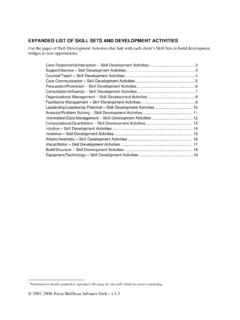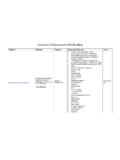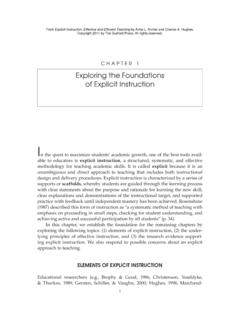Transcription of Issues Distr. General in health services - WHO
1 3 WHO/EIP/ : EnglishDistr. GeneralDetermining skill mix in the healthworkforce: Guidelines for managersand health professionals Issuesin health services deliverySkill mix in the health workforceEvidence and Information for PolicyDepartment of Organization of health services DeliveryWorld health OrganizationGenevaDiscussion paperWHO/EIP/ : EnglishDistr. GeneralIssuesin health services deliveryDiscussion paper skill mix in the health workforce:guidelines for managers andhealth professionalsJames Buchan, Jane Ball and Fiona O MayQueen Margaret University CollegeEdinburghUnited KingdomEvidence and Information forPolicyDepartment of Organization of health ServicesDeliveryWorld HealthOrganizationGeneva2000 Skill mix in the health workforceDetermining skill mix in the health workforce_____iii_____The purpose of the OSD Discussion Paper Series is to promote discussion ofimportant technical Issues between the Department of Organization of health ServicesDelivery and Member States, all parts of WHO.
2 The global scientific community andother partners. It represents work in progress and does not represent an official view ofthe World health Organization World health Organization 2000 This document is not a formal publication of the World health Organization (WHO), and all rights are reserved by the document may, however, be freely reviewed, abstracted, quoted, reproduced or translated, in part or in whole, but not for saleor for use in conjunction with commercial views expressed in documents by named authors are solely the responsibility of those mix in to skill of research on skill mix in for undertaking a skill-mix for skill mix in of approaches to skill analysis/activity Daily diary /self-recording of mix/patient re-engineering.
3 Analysis interviews/ role discussion/ brainstorming mix in theory_____v_____Introduction_____1 IntroductionMost health systems are coming under increasing scrutiny with a view to costcontainment, often as a direct or indirect result of health sector reform. health care islabour intensive, and the level and mix of staff deployed is a central element indetermining the cost of care and the quality of care. It is important that managers andhealth professionals in any health care organization strive to identify the most effectivemix of staff achievable within available resources and organizational report builds on the work already undertaken for WHO in this area, whichdeveloped a typology of approaches to skill mix (Buchan, Ball & O May, 1996; see alsoBuchan, 1999).
4 It examines the context in which decisions on skill mix are made,drawing from country case studies, and provides practical guidelines for healthprofessionals and report aims to: Highlight the different approaches to making decisions on skill mix, givingexamples for each approach; Outline the contextual, political, social and economic factors that play a part in thedecision-making process for determining skill mix; Illustrate the reality of determining skill mix by highlighting the pragmaticapplication of theory and the impact of contextual factors, drawing from countrycase studies; Develop a framework for decision-making, which will assist in identifying whichapproach or approaches are most appropriate, given the main objectives ofmanagers, the availability of data, the characteristics of the organization, the staffgroups involved, the time-scale, etc.
5 ; Draw from the typology and the case studies in order to develop guidelines formanagers and health professionals who are involved in determining skill mix; and Stimulate and encourage further research on skill mix in contextThe report is intended as a support tool for managers and health professionals whomight be interested or involved in skill mix. Section I presents the General lessons frompublished research on skill mix in theory. It examines a conceptual model, andoutlines eight different approaches to skill mix. These approaches are not mutuallyexclusive; organizations will often use a combination of the different , it must be noted that most research is limited in focus, often weak onmethodology, and may not be replicable in a specific context.
6 Also, most research onskill mix has been done in the United States and, is therefore, relevant to that II focuses on skill mix in context. It highlights the importance of theorganizational and system context when assessing which, if any, approach(es) to skillmix may be appropriate for specific III provides guidelines on skill mix in practice. It will help decision-makersdetermine which approach(es) to skill mix can or should be implemented. It highlightsthe four stages in the skill-mix cycle: evaluating the problem; identifying contextual2_____constraints; assessing resource availability; identifying and implementing an Annex provides a detailed description of the eight different approaches to mix in theory_____31.
7 Skill mix in theoryThis section outlines the main approaches to determining skill mix, and highlights themajor implications of previous research in this health systems around the world are coming under scrutiny for cost containmentand quality improvement, often as a direct or indirect result of health sector reform(Buchan and Seccombe, 1994; Kolehmainen-Aitken, 1998). In such a situation, the leveland mix of staff deployed to deliver health care becomes a central element in the cost ofcare, and a major determinant of the quality of that care. health care is labour intensive,and the cost of labour accounts for a high proportion of total costs (often 75% or more).
8 Managers and health professionals are thus striving to identify the most effective mix ofstaff achievable within available is meant by skill-mix ?In practice, service providers can respond to the need to decide on the best mix , byusing one or more of a range of methodologies (as outlined in Section I). Why does thesame challenge of determining skill mix produce different approaches? One reason isthat there is a great deal of variation in what is meant by skill mix or personnel mix .The term skill mix can refer to the mix of posts in the establishment; the mix ofemployees in a post; the combination of skills available at a specific time; oralternatively, it may refer to the combinations of activities that comprise each role,rather than the combination of different job does the term skill mix come from?
9 It is a term that seems to be usedexclusively within a health service context, and yet other organizations and businessesare as likely to want to ensure that they have the most cost-effective combination ofroles and staff to meet their needs. The health -specific label of skill mix should notprevent consideration of current practice in change management and resource planningin other sectors as an approach to skill mix requires a broader vision of resource planning, inorder to help map out the Issues and the methods that can be used to tackle them.
10 Thedanger is that a skill-mix review can become a stand-alone exercise, not linked to otherinitiatives and organizational developments. This can lead to duplication of datacollection, or results can be made redundant if other far-reaching initiatives, (such asreorganization) have staffing implications of their reason for the existence of different skill-mix methodologies is thus partly due tothe various understandings of skill mix and to the different types of problems thatprompt service employers to review skill mix. Using a medical model, these can beregarded as the presenting problems , that is the set of symptoms that a patientpresents before a diagnosis has been made.


















